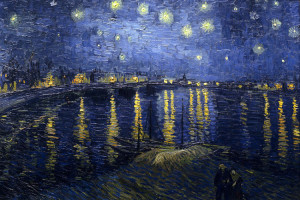By Lida Prypchan
 For the majority of his life, Vincent’s life and wanderings were financed largely by his family, especially Theo. However, while he was in The Hague, Vincent did sell two sets of drawings – a total of 19 drawings – of town landscape sketches to his uncle Vincent. Unlike the bulk of his later works, these drawings were sketches of town sites such as gardens, the gasworks, and the town railway station.
For the majority of his life, Vincent’s life and wanderings were financed largely by his family, especially Theo. However, while he was in The Hague, Vincent did sell two sets of drawings – a total of 19 drawings – of town landscape sketches to his uncle Vincent. Unlike the bulk of his later works, these drawings were sketches of town sites such as gardens, the gasworks, and the town railway station.
After yet another failed romance, and a stay in the hospital for gonorrhea, in the year 1883, Vincent van Gogh moved from The Hague to Hoogeveen, in the northern Netherlands. Up to this point, van Gogh’s work was little more than dense outlines and hatched shading, His desire, however, was to paint, and he felt that he would fine both inspiration and subjects in the working class peasants of Hoogeveen.
It is the general consensus that Vincent was not happy in Hoogeveen. He wrote several letters to his brother and confessor, Theo, begging Theo to join him in Hoogeveen. Theo, however, did not join Vincent. So, Vincent eventually wandered back home, under pressure from his father to settle down. It is widely accepted that Vincent’s relationship with his father was tense at best, and they often argued about the differences they had in opinions, ideas, and views.
The dark, plain world that Vincent used as his inspiration lent itself well to his style at the time. His sketches – hatched drawings – were colored in much the same way he likely observed the world of peasants and hard labor. And, this somber view of the world continued even as he moved from sketches, to watercolors, to oil. His first significant exploration of oil on canvas, financed by his brother, Theo, was a work titled The Potato Eaters.
Vincent’s letters to his brother, Theo, belied his struggle to find meaning through his art. In one letter, Vincent expressed a desire to “create drawings the touch people.” In another letter, Vincent admitted that he sought to “express a sincere human feeling.” In a letter to Theo, dated Sunday, 28 October, 1883, van Gogh wrote:
“I, an artist, I want to live life to the fullest — want to live without ulterior motive — naive as a child, no not as a child, as an artist — with good will, just as life unfolds, so I’ll find something in it, so I’ll do my best in it.”
In the same letter, Vincent wrote that he found the past generation of painters “surprisingly cheerful,” and indicated that such a tone was necessary “against the melancholy aspect of the situation.” However, Vincent felt that “ponderous” was the proper personality for a painter and that it was important for him to do his best to assume such as state in order to ensure that his work was properly expressed. Yet, despite his “ponderous” persona, van Gogh wrote that he found the people of the area – the peasants, farmers, and laborers – pleasant, almost benevolent.
References
Department of European Paintings. Vincent van Gogh (1853–1890). In Heilbrunn Timeline of Art History. New York: The Metropolitan Museum of Art, 2000. Retrieved from http://www.metmuseum.org/toah/hd/gogh/hd_gogh.htm (originally published October 2004, last revised March 2010).
Oxford University Press (2009). Vincent van Gogh (Dutch, 1853–1890). Retrieved from http://www.moma.org/collection/browse_results.php?criteria=O%3AAD%3AE%3A2206&page_number=1&template_id=6&sort_order=1§ion_id=T033021#skipToContent
Van Gogh: The Letters Van Gogh Museum. Retrieved 7 October 2009.
Vincent van Gogh. (2014). The Biography Channel website. Retrieved 01:44, Mar 25, 2014, from http://www.biography.com/people/vincent-van-gogh-9515695.
